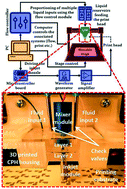A microfluidic-enabled combinatorial formulation and integrated inkjet printing platform for evaluating functionally graded material blends†
Abstract
Sample library preparation is a central step in the process of evaluating materials with the general aim of efficient library formulation while minimizing resource consumption. We demonstrate here the first implementation of a microfluidic-enabled thin film sample library formulation platform with integrated inkjet printing capability for directly patterning these libraries with reduced material wastage. System development and general performance screening protocol for these patterned thin films are described. We study the combinatorial formulation capabilities of this system by focusing on some practical case studies for probing the electrical conductivity in organic, biocompatible and electroactive polymer/additive (PEDOT:PSS/DMSO and PEDOT:PSS/EG) blends. Functionally-graded thin film libraries are prepared by mixing ink components and directly dispensing the processed blends into programmed geometries using the integrated platform. Electrical and morphological characterization of these printed thin film libraries is conducted to validate the formulation efficacy of the platform. Interrogating these printed libraries, we were able to iteratively identify the location of conductivity maxima for the studied blends and corroborate the morphological basis of this enhancement with established theories.



 Please wait while we load your content...
Please wait while we load your content...